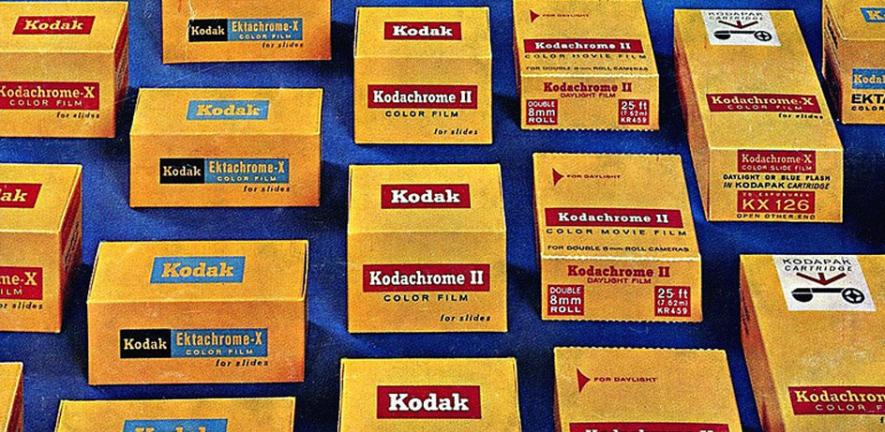
On a shelf in his office in Cambridge Judge Business School, Dr Kamal Munir keeps a Kodak Brownie 127. Manufactured in the 1950s, the small Bakelite camera is a powerful reminder of the rise and fall of a global brand – and of lessons other businesses would do well to learn.
On a shelf in his office in Cambridge Judge Business School, Dr Kamal Munir keeps a Kodak Brownie 127. Manufactured in the 1950s, the small Bakelite camera is a powerful reminder of the rise and fall of a global brand – and of lessons other businesses would do well to learn.
Whenever I ask why a certain company that has fallen on hard times is doing badly, I always start by asking why it was successful in the first place. That is where the answer lies.
Kamal Munir.
Earlier this year, Kodak filed for Chapter 11 bankruptcy protection. But when Kamal's camera was made, the company bestrode the world of amateur photography – a world Kodak itself had created.
Established by George Eastman in the 1880s, by the 1950s Kodak had the lion's share of the US amateur film market. “Kodak was a company at the top of its game,” says Kamal, who has studied the Rochester-based business for more than a decade.
“Kodak controlled almost 70% of the highly lucrative US film market. Gross margins on film ran close to 70%, and its success was further underpinned by a massive distribution network and one of the strongest brands in the world. The company completely dominated its industry,” he says. “And then, in 1981, along came digital.”
Thousands of words have been written recently seeking to explain Kodak's failure. The company, all agree, was slow to adapt to digital, its executives suffered from a mentality of “perfect products”, its venture-capital arm never made big enough bets to create breakthroughs, and its leadership lacked vision and consistency.
None of this analysis, however, fully explains why digital – a technology Kodak pioneered – did for the company. Understanding that, Kamal argues, requires a deeper historical and social approach.
“Photography is very much a social activity. You can't really understand how people relate to their pictures – why people take pictures – unless you do a social analysis which is more anthropological or sociological,” he explains.
“Whenever I ask why a certain company that has fallen on hard times is doing badly, I always start by asking why it was successful in the first place. That is where the answer lies.”
For three-quarters of the twentieth century, Kodak's supreme success was not only developing a new technology – the film camera – but creating a completely new mass market.
During the nineteenth century, photography had been the exclusive preserve of a small number of professionals, with their large-format cameras and glass plates. So when Kodak invented the film camera, it needed to teach people how and what to photograph, as well as persuading them why they needed to do so.
“Kodak is the company that made photography a popular pastime around the world. It made a tremendous contribution to how we see things,” Kamal says.
The Kodak moment
Kodak's high-profile advertising campaigns established the need to preserve 'significant' occasions such as family events and holidays. These were labelled 'Kodak moments', a concept that became part of everyday life.
And it was women Kodak cast in the leading role. In its advertisements, women held the cameras, busy preserving moments of domestic bliss for posterity: “Kodak knew how to market to women. If you wanted to be seen as a caring mother and responsible housewife, then you needed to record your family's evolution and growth,” he says.
But women were only part of the story. It was they who took the photographs, but the other half of the Kodak moment required a subject – birthday parties, sporting success and, crucially, family holidays.
“Kodak also played a big role in converting travel to tourism. The idea was that if you hadn't brought back pictures from your vacation you might as well not have gone,” says Kamal. “For them, photography was all about preserving memories for posterity, photography was all about sentiment, and it was women who were doing this.”
By the 1970s, more than 60% of pictures in the US – the world's largest photography market – were being taken by women. And it was partly how men – rather than women – responded to the digital revolution that Kodak couldn't cope with.
Digital disrupted the company's equilibrium in two crucial respects. Firstly, it shifted meaning associated with cameras and secondly, digital devices allowed newcomers such as Sony to bypass one of Kodak's huge strengths – its distribution network.
Gadget man
The knock-on effects of this shift were enormous. Digital cameras came to be viewed as electronic gadgets, rather than pieces of purely photographic equipment. As a result, he explains: “The identification of cameras as gadgets brought about another significant change: women were no longer the main customers, men were.”
The gender shift led to the third source of disruption for the photographic industry in general, and for Kodak in particular. With digital cameras, images could be viewed on cameras, mobile phones or computers without the need for hard prints. And with women giving way to men as primary users of cameras, printing plummeted.
According to Kamal: “The people taking pictures suddenly changed, from 60% women to 70% men. Kodak didn't know how to market to men. But even if they could get them to buy, they didn't want to, because men don't print. Unlike women, they hadn't been socialised in the role of family archivist.”
Faced with such an enormous threat to its business, Kodak did what many companies do in similar circumstances – ignore the problem in the hope it goes away, and when it doesn't, deride the new-comer.
“Some things do go away – not all technology gets diffused,” he says. “When that fails, the second reaction is usually derision – it'll never take off, it's too expensive, it's too difficult, the print quality is too bad, people will never part with hard prints. When I talked to Kodak executives they would always cite the same example – if someone's house catches fire, the first thing they rescue is their photographs.”
From preserving memories to sharing experiences
Having played such a central role in creating meaning for photography, the company failed to believe that meaning had changed, from memories printed on paper to transient images shared by email or on Facebook.
“The change from preserving memories to sharing experiences, and from women to men – these were things Kodak simply couldn't handle,” says Kamal, who saw the writing on the wall when he visited the company's senior management in Rochester a decade ago. “By the end of the day I was convinced the company was not going to be around much longer.”
In 2006, Kamal sent a letter to the Financial Times, pointing out that Kodak's strategy was fundamentally flawed. “Kodak is better off taking a leaf out of Lou Gerstner’s strategy for re-inventing IBM – from a manufacturer to a service-provider,” he wrote.
“Kodak needs to disassociate itself from its traditional strengths and come to terms with the fact that this technology will be commoditised sooner or later. What they need is a new business model for an environment in which people do not ‘preserve memories’ but ‘share experiences’ ... I am afraid Mr Perez's [Kodak CEO] strategy of engulfing the consumer in the Kodak universe has a low likelihood of success."
But rather than a new business model, what Kamal had seen in Rochester was a digital imaging division under pressure from its consumer imaging counterpart, and a company unable to shake-off a corporate mindset that had developed over more than a century.
“Its focus on retail printing, investing in inkjet printing research and development, and selling sensors to mobile manufacturers – altogether, these never added up to a coherent, sustainable business model. And the digital guys were always under pressure because they were seen to be cannibalising sales of much more lucrative products,” says Kamal, who thinks Kodak should have cut the digital business loose and freed it from the Rochester mindset.
Learning from history
In his view, Kodak needed to let a new generation of users and entrepreneurs take charge – people who could embrace uncertainty and were prepared to be driven in unforeseen directions – a far cry from how the company had spent its life.
“It's important for companies to reinvent themselves. Kodak had tremendous market power – one of the things that allowed it to survive thus far. But for this kind of reinvention, where you're faced with a technological discontinuity which has little in common with what you've been doing, you need to radically alter your mindset or world-view and emerge as a completely different company. IBM is a good example of this kind of reinvention, which was a huge cultural shift and took several years. But Kodak wasn't willing to part with their legacy.”
The challenges Kodak faced are not unique, so what can other businesses learn from its failure? Clearly companies that derive a large proportion of their profit from a single product – in Kodak's case film – are more vulnerable. But having a corporate mindset open to new ideas and able to embrace uncertainty is essential.
According to Kamal: “The important things are not to tie the weight of legacy assets onto new ventures; to refrain from prolonging the life of existing product lines, while trying to create false synergies between the old and the new; and, most of all, to base strategy around users, rather than the existing business model.”
As the company approaches its 130th birthday, what will be its legacy? Those precious family albums, perhaps, and our enduring passion for photography. But its impact could have been even greater, and longer-lasting.
“There was a time when photography was known as 'kodaking',” he concludes. “I don't think Kodak will survive. Someone might buy the brand and its assets, but Kodak is never going to be Kodak again.”
This work is licensed under a Creative Commons Licence. If you use this content on your site please link back to this page.





